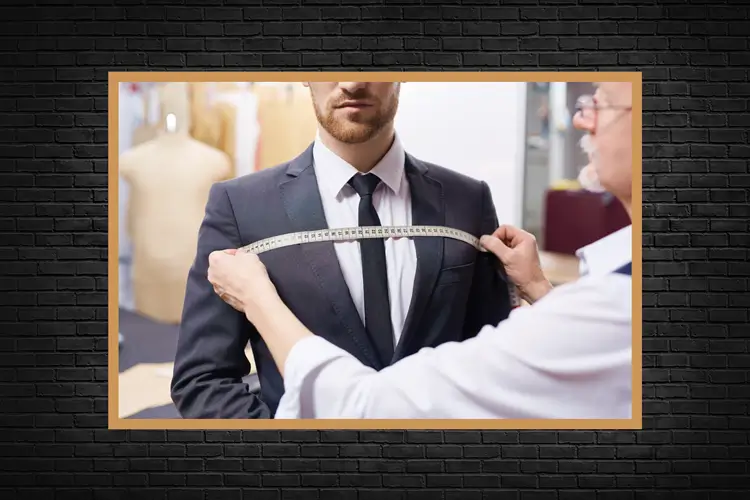Y our suit’s fit is the single most important factor you need to nail if you want to look poised, polished and powerful (plus a bunch of other words that don’t start with “p”) when you suit up.
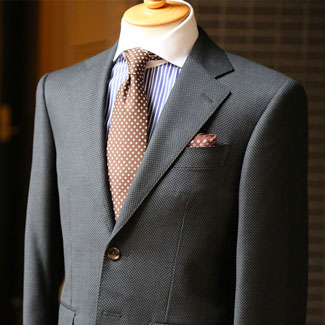
Sure, there are other things to consider, from fabric and color, to the dress shirt, shoes and accessories you pair with your suit.
But make no mistake: fit is king.
Guys with a good fit look commanding and confident in a suit, while guys with a bad fit look like a 14-year-old boy who just raided their dad’s closet.
In this post I’ll dive into the details to show you how a suit should fit, and break down the most important elements that will help you find the perfect fit for your kit.
How Should a Suit Fit?
The Ultimate Guide to Getting the Perfect Fit
First Thing First:
What Your Suit Should Look Like
You can’t get anywhere if you don’t know where you’re going.
So before we dive into the details of how your suit should fit, it’s important to understand the overall shape and appearance that makes a man look his best.
The Perfect Suit Proportions:
What is the Golden Ratio?
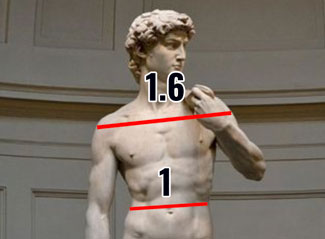
The reason that proper fit is such an important factor in determining whether or not you look sharp can be found in both art and science.
Fit is the single biggest factor that affects your proportions, and there’s actually a mathematical formula for determining the perfect proportions for a man’s body: the Golden Ratio.
If you’re into fitness or bodybuilding you may be familiar with the Golden Ratio, which states that dimensions of 1 to 1.6 are both the most mathematically sound and the most eye-pleasing body shape.
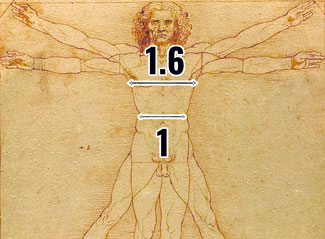
Once you become aware of the Golden Ratio, you’ll start seeing it everywhere, especially in historically significant works of art and science.
For instance, in Leonardo da Vinci’s Vitruvian Man drawing, which is basically a blueprint for the human form, the guy in the drawing conforms to the Golden Ratio.
In Michelangelo’s Statue of David, David also perfectly conforms to the Golden ratio.
(That’s two out of three Ninja Turtles who have used the Golden Ratio!)
How the Golden Ratio Affects Your Suit’s Fit
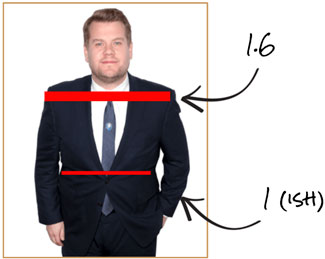
So, what does this have to do with how a suit should fit?
A lot, actually.
Studies have shown that women are most attracted to men whose shoulders measure 1.6 times the size of their waists.
So the Golden Ratio isn’t just relevant to art and science, it’s also relevant to the way our clothes fit.
Style is about looking good (obviously), and while looking good can be very subjective, the Golden Ratio gives us an objective standard to aspire to.
Think of it as sort of the North Star of Style.
Studies have shown that women are most attracted to men whose shoulders measure 1.6 times the size of their waists.
The more that the silhouette of your fitted suit resembles the Golden Ratio, the more eye pleasing and attractive you’re going to look.
And the best way to affect your silhouette and get it to resemble the Golden Ratio is by making sure your clothes fit properly.
If you happen to have a statuesque body, you want your clothes to fit in a way that highlights your physical proportions.
But if, like most of us, your body type is more “regular guy” than “Greek God,” then you want your clothes to mimic these proportions as much as possible.
And that’s where your suit comes in.
Projecting Strength with Your Suit
The good news is that the fit of a suit does more to mimic and project the Golden Ratio than any other type of clothing.
It’s a big part of the reason why men have been wearing some version of a suit for hundreds of years now, and will likely continue wearing them for many years to come.
So now that you what the perfect fit is and why it’s so advantageous, let’s do a deep dive to find out how to achieve it and get the right fit.
How a Suit Jacket Should Fit
Your upper body usually gets noticed more than your lower your body, which means that the most important aspect of the suit’s overall fit is how the jacket fits.
Let’s take a look at the seven main aspects that contribute to the perfect jacket fit: jacket length, shoulders, sleeves, torso, lapels, armholes and button stance.
Suit Jacket Length
How long should a suit jacket be?
The most important thing to know about the length of your jacket is that you want it to make your upper body looked balanced when compared with your lower body.
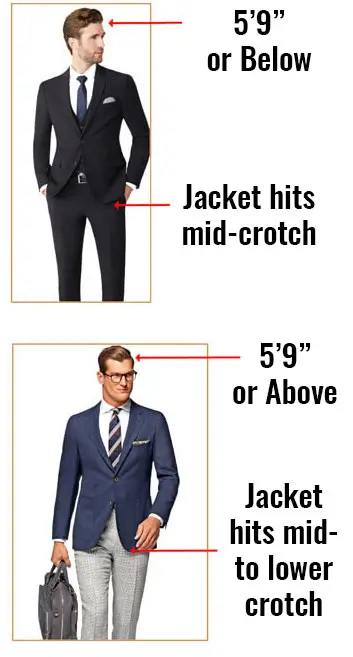
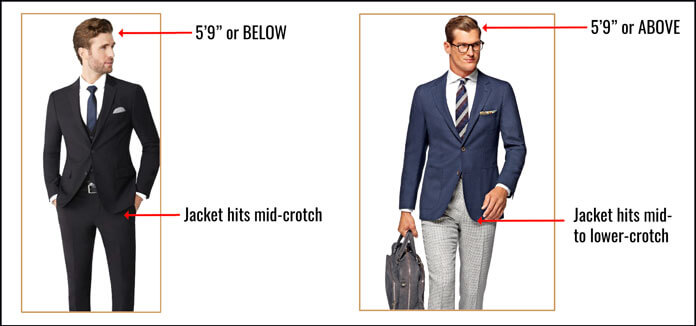
Here’s an easy rule of thumb to follow:
If you’re 5’9” or below, you want the bottom of the jacket (also called the hem of the jacket) to hit around the middle of your crotch.
If the jacket goes down any lower it will look too long on your frame, and risk giving the impression that you’re shorter than you really are.
If you’re above 5’9”, you want it to hit either at mid crotch or just a little lower.
Taller guys tend to have longer legs, and may want longer jackets as well.
If you’re 6′ or above, you may want the jacket to go a touch lower and hit near the bottom of your pant pockets, which will help maintain better balance with your lower bodies.
Keep in mind that changing the length of the jacket is something that’s relatively easy for tailors to do.
Chopping off too much will start to affect the jacket’s proportions, but they can usually take it up about an inch without causing any problems.
Suit Shoulders
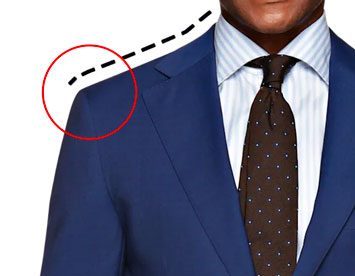
Arguably the most important aspect of suit jacket fit is the jacket shoulder.
Buying a jacket in the wrong shoulder size is a common problem, and one that unfortunately can’t be fixed after the fact.
It’s basically impossible for a tailor to change the shoulder of your jacket, so when you’re buying a suit off the rack, shoulder fit is the number one area you want to get right.
As with your shirts’ sleeve seam, you want the shoulder seam of your jacket to hit right at the point where your shoulders start to curve down toward your arm.
If there are any wrinkles or divots in the shoulder pads when you have your arms down at your sides, it’s a sign that the jacket doesn’t fit properly. You want the shoulders to just lay flat.
Guys whose own shoulder blades are a little more rounded may find that they like to have a little extra padding in the shoulder of their suits, to give the appearance that their shoulders are broader.
A broad shoulder will make your waist look smaller by comparison, and really help mimic the Golden Ratio.
Suit Sleeves
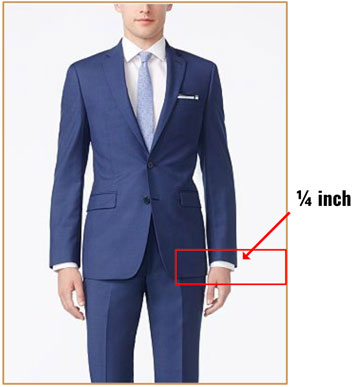
To check the length of your sleeves, stand up straight and let your arms hang loose at your sides, then bend your wrist so that your flat hand face the floor.
The jacket sleeves should rest about a quarter of an inch above your hand.
Ideally, you want about a quarter inch of shirt cuff to be popping out from your jacket sleeve.
So when you do this exercise, your shirt sleeve should hit the top of your hand, and your jacket sleeve should be a quarter inch up.
Unlike shoulders, sleeves are an easy fix for tailors, so if they’re too long you can easily have them adjusted.
But as with the bottom of your jacket, there’s nothing a tailor can do if the sleeves are too short, at which point you’ll have to get a different size.
Torso
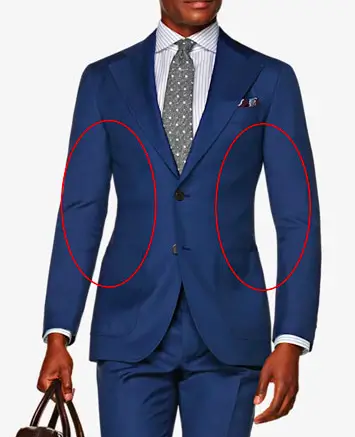
The jacket’s torso is the second most impactful area (after the shoulders) when it comes to achieving the Golden Ratio.
Fortunately, it’s also a common fix for tailors, who can easily take in the sides of the jacket.
The key to getting the best fit for the torso is to make sure that the body of the jacket comes in at your waist, so that there’s plenty of space between your sides and your arms.
If you got the shoulder width right, then creating a silhouette that’s in line with the Golden Ratio should really just be a matter of having your tailor take the jacket in at the sides.
How to Get the Perfect Fit for Your Torso
Do the suit’s top button up, then ask your tailor (or someone else, if you’re doing this at home) to pull the jacket back until you achieve the look you want.
Once you’ve got the right silhouette, pin the sides so the jacket stays in place.
Next, put your fist behind the button, in between the jacket closure and your stomach.
If there’s enough room for your fist to slide in easily, the jacket is too loose. But if your fist doesn’t fit in there at all, the jacket is too tight.
The perfect balance is when you can just barely squeeze your fist in between the button and your stomach.
At that point it should cut a svelte shape, but still leave you with enough room to move around.
WARNING: Don’t Be an “X” Man*
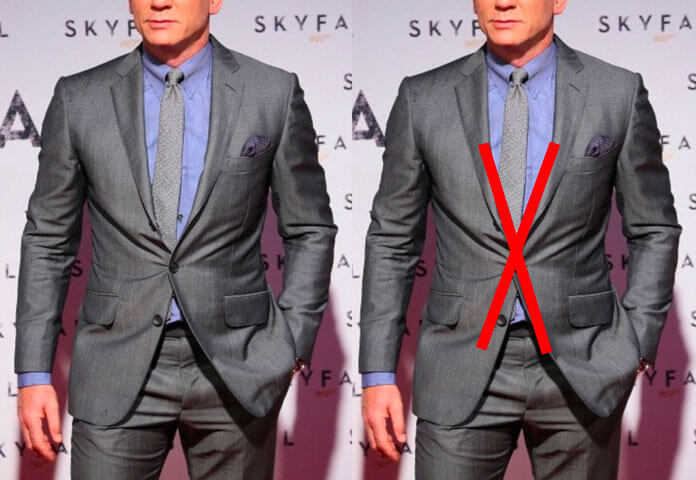
Another visual cue that indicates a common fit problem is the “X” that forms when your jacket is too tight.
Although this can still conform to the Golden Ratio, it takes things a little too far, making it look like you’re about to bust out of your jacket the way the Hulk busts out of Bruce Banner’s pants.
Which might be fine if you’re a gamma-radiated superhero charging into battle, but isn’t, like, the best look for formal wear.
Did you know…?
As a rule you never want to do up the bottom button of your suit.
No one knows exactly why or how this tradition started, but one theory attributes the rule to King Edward VII of England.

In the early 1900s he was just too fat to do up the bottom button of his jacket and started leaving it undone, which prompted the gentlemen of the court to follow suit.
This isn’t a particularly sound reason, but the tradition has stuck, and today doing up the bottom button of your jacket is considered a rookie move you want to avoid.
Lapels (aka Suit Collars)
The jacket collar is called the lapel, and it should rest comfortably against the shirt collar on the back of your neck.
You basically want a light amount of contact between the skin on your neck, your shirt collar and your lapels.
Not so much contact that you feel restricted in any way, but enough so that there’s no daylight between them.
Note that this collar gap rule holds true regardless of whether your jacket has a notch lapel, a peak lapel or a shawl collar.
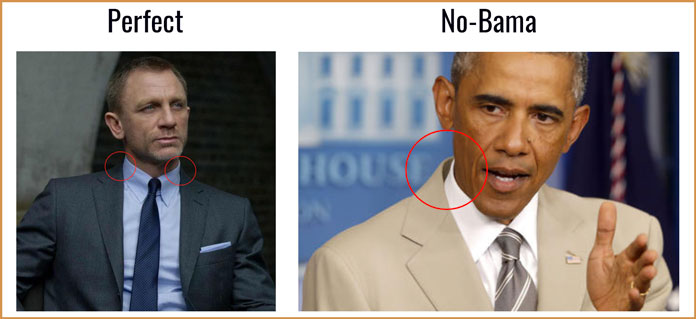
Armholes
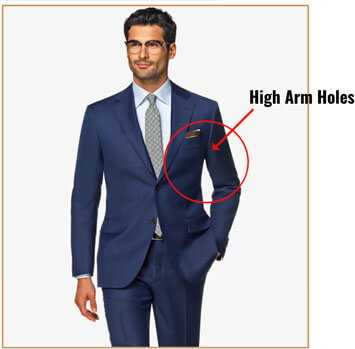
You want the armholes of your jacket to be high, so that there are significant gaps between your arms and your torso.
If the armholes are too low, they’ll droop down, and too much fabric under your arms can make the torso look wide, throwing off your proportions.
(One of the biggest differences between custom suits and the kind you buy off the rack is that off-the-rack suits often have lower “one-size-fits-all” armholes.)
Sliding your arms into the armholes should be easy.
If you encounter some resistance, it’s a sign that the armhole is too small and the sleeves are going to be too tight.
On the other hand, you’ll know the sleeves are too loose if you can barely feel them sleeves when you put your arm in.
Don’t Throw Your Hands Up in the Air
(Because You Do Indeed Care)
You might find that your arm movements are a little restricted in a suit jacket (especially if you’re wearing a slim-fit suit), but that’s totally normal.
If you’re doing something that requires a full range of motion, then you probably shouldn’t be wearing a suit in the first place.
But you can always pop your jacket off and leave it on the chair if you need to go bust a move on the dance floor or, I dunno, fight on top of a train.
Button Stance
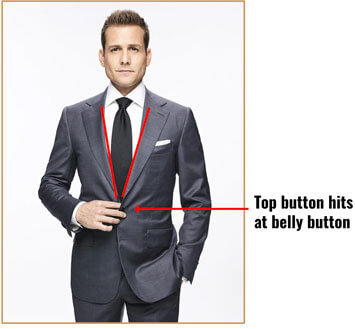
One last element of how our jacket fits is something that a lot of guys never think about, but plays an important role.
Button stance refers to where on your body the top button sits.
On a two-button suit, which is the most popular and in my opinion the most stylish style of suit, the rule of thumb is that you want the top button to hit just above your navel.
This creates the perfect angle for the “V” formed by the jacket’s lapel.
It’s ok if the suit button lies a little bit above the belly button, but you want it to be within an inch or so.
What you don’t want is for the button to hit below your belly button, because that would mean the proportions of your suit are pretty drastically out of whack.
(Note that if you’re wearing a three-button jacket, which I wouldn’t advise, it would be the middle button that sits at or just above the navel.)
How Suit Pants Should Fit
The handsome devil is in the details, so while your upper body will likely get more attention than your lower, your pants are still an important consideration.
Fortunately, getting the ideal fit for you pants is a little easier than with your jacket because there are only three critical areas that you have to worry about: the waist, the seat and the length.
Waist
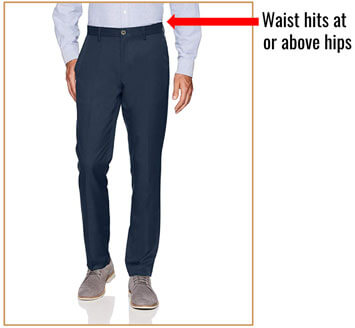
Unlike more casual styles like jeans or chinos, you want your suit’s pants to sit at your hips, or even a little higher.
(This is especially true if your waist size is a little bigger, in which case wearing your pants too low presents a pretty big risk of them slipping right off if they’re not sized properly.)
If your zipper or lower crotch bunches up, it’s a sign that your pants are sitting a little too low.
You want the waist of your pants to fit snuggly enough that you don’t actually need to wear a belt, although you can if you choose. (Unless your suit comes with side tabs instaed of belt loops, in which case wearing a belt is basically impossible anyway.)
To test if you’ve got the right fit, do up your pants and try squeezing two fingers into the waist band.
If you can’t get two fingers in, they’re too tight, but if you can fit three or more in, they’re too loose.
Seat (aka Butt) and Legs
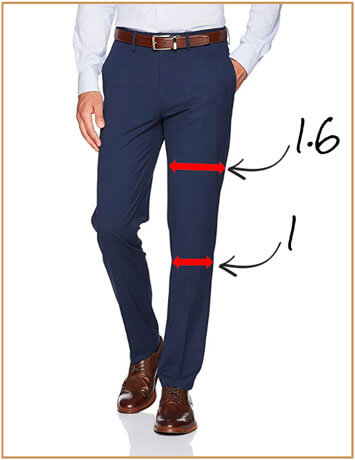
Moving down from the waist, you want the pants to fit slim and hug your body pretty closely, creating a straight line that angles down slightly from your waste to your ankles.
But you don’t want your pants to be so tight that your crotch and rear end are crammed in there like sausages, either. (Otherwise everyone will be able to see your sausage.)
The same thing goes for your legs. Your quads are usually quite a bit wider than your calves, so you want a leg opening that allows you to slide them in easily at the top.
The fabric should hue closely to your body all the way down your leg, which means it should begin to taper around the knee so that the leg opening is narrower near the ankle.
If your jacket fits properly and you’ve nailed the Golden Ratio with your upper body, this will nicely continue the trend as the eye moves down your silhouette.
Pant Length/Ankles
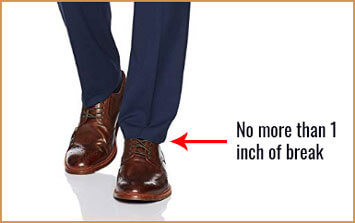
Your suit’s pant length is important because a pair of dress pants that fits perfectly everywhere else but bunches too much at the top of your shoe will end up looking sloppy instead of sleek.
The best practice is to have no more than one inch of what’s called trouser break, which is the point at which your pants create a divot near your ankle.
Back in our grandfathers’ day, it was standard for men to opt for a full break, which essentially meant wearing pants that were a bit too long, and letting them “break” (i.e. bunch up a little) at the top of the shoe.
But the modern look is more refined, and leans towards a softer break, if any.
Having no break means that when you stand up straight, your pants hit right at the ankle and barely graze the top of your foot, if they touch the foot at all.
This looks great while you’re standing, but it means that your pants will ride up your ankles quite a bit when you’re seated.
I don’t mind this look, especially if your sock game is on point.
But my personal preference is to have a slight break – again, no more than an inch – so that there’s still some fabric to keep my calves covered when I’m seated.
More Resources ↓
More Men’s Suits and Style Advice Irreverent Gent:
- How to Buy Your First Suit
- The Best Suit Brands for Men of Every Shape, Size & Budget
- The Best Athletic Fit Suits for Muscular Men
- The Most Stylish, Stretchy & Comfortable Suits for Men
- Business Casual Menswear: The Ultimate Guide
- The Ultimate Guide to Male Semi Formal Attire
- How to Shop for Men’s Clothes
- How to Look More Handsome and Attractive
- The Best Athletic Fit Dress Pants for Men
- The (Absolute) Best Athletic Fit Dress Shirt for Muscular Guys
- The Quickest, Most Effective Way to Measure Your Sleeve Length
- How to Create a Personal Style Profile
- How to Measure Your Pants Inseam
- In Review: Alain Dupetit’s (Suspiciously Affordable) Suits
- The 21 Best Shoes to Wear with Shorts
- The Best Men’s Wrinkle-Free Dress Pants & Non-Iron Casual Pants
- In-Depth Indochino Review – Are custom suits worth it?
